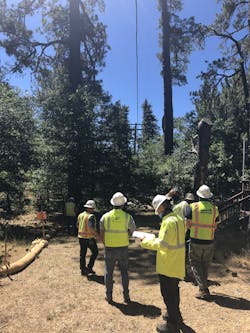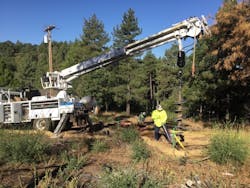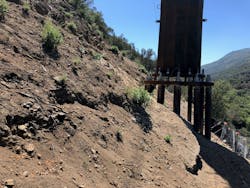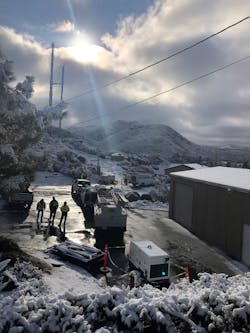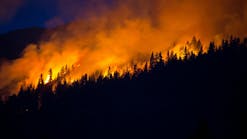Forged Against Fire: Details from SDG&E's Wildfire Hardening Project
In response to catastrophic wildfires in San Diego County in the early 2000s, San Diego Gas & Electric Co. developed a fire-hardening project that has become the cornerstone of the utility’s wildfire mitigation program and system-hardening efforts. The Cleveland National Forest (CNF) project encompassed a variety of wood-to-steel pole conversions and the replacement of conductors with more fire-resistant equipment throughout approximately 880 sq mile (2279 sq km) in eastern San Diego County, including the communities of Julian, Pauma Valley, Descanso, Pine Valley, Mount Laguna and Campo — areas with some of the highest fire risk.
The wood-to-steel pole conversions and conductor replacements were numerous: Approximately 150 miles (241 km) of older electric T&D wood-pole infrastructure in high-risk fire areas (HRFA) were rebuilt with new fire-resistant steel-pole infrastructure. A portion of the scope also involved 17 miles (27 km) of underground conversion of electric distribution located in high-priority areas within the national forest.
The project was initiated in partnership with the local CNF as part of an effort to consolidate more than 70 special use permits issued by the U.S. Forest Service dating back to the 1940s and 1950s. What started as a plan to consolidate these 70 permits into one master special use permit evolved into a much larger project to fire harden the electric infrastructure after a series of devastating wildfires ravaged areas of San Diego County in 2003 and 2007.
Scope of Work
Because of the scope of work and potential environmental impacts of replacing the electric infrastructure, a joint environmental impact report/environmental impact statement (EIR/EIS) was developed with the California Public Utilities Commission (CPUC) and U.S. Department of Agriculture (USDA) Forest Service as the state and federal lead agencies, respectively. In 2012, an application for a permit to construct was filed and an environmental evaluation was conducted for each of the six transmission and five distribution lines. The project was approved in 2016 by both the CPUC and CNF.
The CNF project encompassed a total of 11 69-kV transmission line segments and 18 12-kV distribution circuits, both underbuilt on the transmission and stand-alone distribution lines. This project was designed with known local wind conditions, based on data from more than 200 weather stations within SDG&E’s service territory. More than 1120 transmission poles and 112 miles (180 km) of conductor were replaced with a combination of pre-engineered direct-embedded steel poles, engineered poles on drilled pier foundations and micropiles — small-diameter, high-capacity, drilled and grouted-in-place piles designed with steel reinforcement. The existing transmission conductor — a combination of aging small aluminum conductor steel-reinforced (ACSR) and copper — was replaced with conductor using a steel core.
The transmission designs incorporated longer insulators and expanded spacing to limit the potential for wire-to-wire and wire-to-ground contact, which could result in a fire. To increase reliability in the area, two segments were converted to double-circuit transmission lines to bring additional transmission lines into the substation, and 19 miles (31 km) of the most exposed line along with its 277 structures in the Tier 3 high fire threat district and 111-mph (178-kmph) wind area were removed. Another 60 miles (97 km) and 1221 poles of distribution were replaced with steel poles with fiberglass crossarms, and conductor using a steel core replaced the aging copper and all-aluminum conductor infrastructure. As part of the scope of work, SDG&E also performed 17 miles of electric distribution overhead to underground conversion. SDG&E made some operational changes because of this project:
- Implemented new facility design, construction and maintenance standards, such as enhanced tree trimming and brush clearing, frequency of patrols and increased spacing between power lines.
- Enhanced electrical system protection, equipment replacement and use of wireless fault indicators.
Overcoming Challenges
Because of the remote and mountainous topography of the project area, combined with the circuit and branch outages required during installation, there were numerous construction and safety challenges. Helicopter construction was required across more than 40% of the project because of limited road access.
The project also traversed many areas in San Diego County with sensitive environmental resources, which added to the challenges during design and construction. This included land previously and currently inhabited by Native American Tribal Nations, riparian areas and sensitive vegetation communities. The project team was challenged with how to rebuild the infrastructure safely while avoiding or minimizing the effect on these important resources. This required SDG&E’s engineering and environmental teams working closely together to design around these resources where feasible, using comprehensive field survey data of known environmentally sensitive areas. The result was designs that changed the alignment to remove poles from sensitive areas or to go around them whenever possible.
One of the most environmentally challenging aspects of the CNF project was circuit 440/442 on top of Mount Laguna. Along with many sensitive resources in the area, SDG&E had to contend with weather delays and snow limiting road access in the winter as well as fire weather restrictions in the summer. Working with the U.S. Forest Service and Native American Tribal Nations to avoid or minimize impacts to sensitive and cultural resources, SDG&E forged ahead with the project.
The challenges and hurdles were many and diverse. Despite the various obstacles incurred, the overall safety performance during the nearly five years of construction was impressive. With over 1.9-million man-hours worked by contractors and employees in the field, the project experienced only 14 Occupational Safety and Health Administration (OSHA) recordable injuries, no fatalities and a total recordable incident rate (TRIR) of only 1.47.
In addition to the complex variety of projects, outage scheduling, weather challenges, and sensitive vegetation and riparian resources, the team also had to navigate the COVID-19 pandemic. When the corona virus hit last year and the stay-at-home order was issued in March 2020, the project team realized work could not proceed as normal on several of the projects because a lengthy outage would be difficult for customers who were sheltering at home in freezing temperatures in the eastern part of the county, where it snows in the winter.
Facing these new challenges, the team harnessed additional innovation and created a plan to prioritize and consolidate the number of outages. They offered impacted customers a back-up generator and fuel to maintain power to their property so work and schooling could continue at home uninterrupted.
Ten Years in the Making
The SDG&E team completed the last line segment of the CNF project on July 15, 2021.
“It’s been an incredible experience to be a part of this project and working with such a talented group of people for the past 10 years,” said Knowd. “Just knowing that the CNF project plays a vital role in SDG&E’s commitment to making our electric system more resilient to prevent future wildfires makes me very proud.”
The CNF portfolio of projects is just one of many wildfire projects included in SDG&E’s wildfire mitigation plan filed with the CPUC each year. In accordance with Senate Bill 901, the wildfire mitigation plan outlines the ongoing practices and additional improvements SDG&E will make beyond the investments the utility already has made to combat the effects of the changing climate and threat of year-round wildfires. The completion of the CNF power line replacement project will undoubtedly enhance the safety of the electric grid in San Diego County for years to come.
Tim Knowd is a program manager in SDG&E’s transmission and distribution division. Most recently he managed several large capital projects as part of the utility’s wildfire mitigation program, including the Cleveland National Forest power line replacement project and electric system hardening projects. Knowd has a bachelor’s degree in forestry and natural resources management from California Polytechnic University, San Luis Obispo. He started his career as a wildland firefighter for the U.S. Forest Service during college and after, before joining SDG&E’s vegetation management team in 1998 as an area forester and program manager with additional duties as a fire coordinator, where he served as the liaison between responding fire agencies and SDG&E’s first responders like electric troubleshooters and line crews. He also worked as a construction manager at SDG&E’s Orange County and Northeast Operating Centers as well as the safety and compliance manager on the Sunrise Powerlink Project, a US$1.8 billion, 117-mile (188-km) transmission line project.

